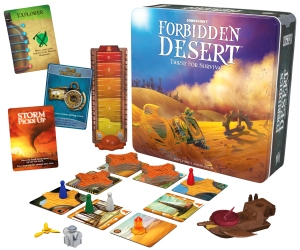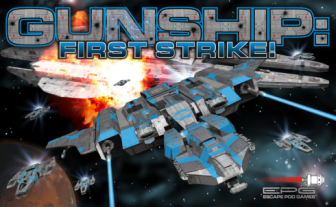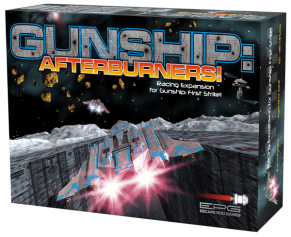 Designer: Matt Leacock
Designer: Matt Leacock
Publisher: Gamewright
Players: 2-5
Ages: 8+
Time: 30 minutes
Times played: 7 (with review copy provided by Gamewright)
I love Aaron Sorkin when he’s writing in “full-on rant” mode:
Lewis: People want leadership, Mr. President, and in the absence of genuine leadership, they’ll listen to anyone who steps up to the microphone. They want leadership. They’re so thirsty for it they’ll crawl through the desert toward a mirage, and when they discover there’s no water, they’ll drink the sand.
The President: Lewis, we’ve had presidents who were beloved, who couldn’t find a coherent sentence with two hands and a flashlight. People don’t drink the sand because they’re thirsty. They drink the sand because they don’t know the difference.
from the film THE AMERICAN PRESIDENT
In the case of Forbidden Desert, they drink the sand because, well, it’s everywhere.
Ah, yes, Forbidden Desert – the much-anticipated “sequel” to Matt Leacock’s family-oriented cooperative game hit, Forbidden Island. Evidently, your success at rescuing the treasures has inspired you & your team to travel into the deepest desert to find a fabled lost city – and a marvelous flying ship.
Of course, things go wrong. (Cue up the chaos theory speech from Jurassic Park.) Your helicopter crashes… just as a wicked sandstorm blows into the area. Your only hope is to complete your mission and reconstruct the flying ship to use an escape vehicle.
In the midst of a growing sandstorm and the blazing heat of the desert sun, you must find the four missing pieces of the ship, bring them to the launch pad, and fly away to safety.
Compare & Contrast: Is This Just a Retread of Forbidden Island?
Short answer: No.
Longer answer: While it shares certain mechanical similarities with Forbidden Island…
board formed from two-sided tiles
card deck triggering the game’s “attack” on the players
escalating number of cards drawn as the game progresses
roles for each player that grant a particular way to break the rules
…Forbidden Desert is a fresh game with it’s own personality and style. The need to excavate tiles to both gain tech (equipment) and to find the pieces of the flying ship mean that you’re doing less “protecting” of spaces (a common tactic from Forbidden Island). At the same time, you have to carefully manage another resource – water – to prevent one of your team of dying from thirst… and thus have to be careful about sending out adventurers on their own into the wasteland.
The board itself is more interactive than Forbidden Island. While the island simply offers you locations to grab the objective totems, the desert board not only needs to be excavated but also has tunnels (both for easier movement & safety from the burning sun). The clues for the location of the various items are there… along with water supplies & the ability to get tech/equipment to help you out when things go pear-shaped.
The sand storm generates obstacles (sand – loads & loads of the aforementioned grainy stuff) in a way that gives the team a feel for where it might be going, especially in the early part of the game. One of the game timers is the sand itself – if you can’t place any more on the board, the city (and you!) are considered to be buried, waiting for Indiana Jones to discover your weathered bones.
Finally, the greater number of actions (4 per turn per player) means that you have more potential to affect the progress of the game… and more options for decision-making.
Note: I still really like Forbidden Island – go & read my review on my personal blog. (Just come back & finish reading this one!)
A Not-So-Detailed Detailed Analysis of the Storm Deck
The Storm deck is used after each players’ turn and essentially acts as the “brain” of the game. It triggers the intensity of the storm (there are three cards which up the level, similar to the water level in Forbidden Island). It sucks water out of your canteens (there are four cards that force you to drink – unless you’re under a Solar Shield or safely hidden in a tunnel.)
The rest of the deck (24 cards) moves the storm (an empty space in the 5×5 grid that makes up the game board) 1, 2 or 3 spaces… and each tile that is shifted receives a sand marker. The average amount of sand deposited on the board is roughly 1.3 sand per card – which means you need to watch the pool of sand tokens carefully, especially as the storm increases in strength (number of cards you draw).
Because tiles that can not be shifted don’t receive sand, that rough average number is probably a little bit lower – still, my 7th grade son quickly figured out that once you’re drawing four cards per turn, you have the potential to dump 12 sand onto the board in one set of draws.
The storm severity meter is actually four different meters for 2, 3, 4 or 5 players… which works very well. (We’ve played with 2, 3, 4 & 5 players – the game plays smoothly with any size group.)
Mark’s Mini-Thesis on Cooperative Games – As Applied to Forbidden Desert
For me, cooperative games succeed or fail on some simple questions:
1. Is there a coherent and/or compelling story arc to the game?
Yes. The need to explore to find the flying ship pieces while racing the growing storm works like a charm.
2. Are there meaningful decisions to be made by the players?
Yes. The analogy I used to discuss this with friends was a plate-spinner. (Yes, like something you’d see on Star Search – pop culture reference for my well-seasoned readers – or America’s Got Talent – pop culture reference for the young whippersnappers.) Forbidden Desert has you & your fellow players spinning a lot of plates: water supply, exploration, sand removal, not wasting time, when to use tech and/or character powers.
So, while each decision in & of itself may seem obvious (“go pick up the propeller before it’s buried in sand!”), deciding the priority and order of those actions is much like keeping plates spinning. You see one wobble (“the launch pad is getting buried”) and you lunge to fix it… but your effort there means something else has to wait for your attention.
3. Is the game system have enough randomness to offer a new play experience each time… while predictable enough to make the players feel like they have both strategic & tactical choices? (Note: I didn’t say that players HAD to have strategic choices – just that they felt like they did.)
Yes. The randomness of the set-up combined with the inherent vagaries of the Storm deck bring a lot of variety to the game… while the sandstorm mechanic (in which players know the starting point of the sandstorm before drawing from the deck) and the set objective make it easier for players to develop strategic & tactical plans.
4. Is the game susceptible to a player/dictator?
One of the problems inherent in cooperative games is having one player “direct” the play of the rest of the players to solve the puzzle. There are various ways to solve this as a game design problem: hidden information, real-time play, appointing a leader, etc.. (Or my favorite home remedy: don’t let obnoxious people play games with you.)
In the process of writing this review, I asked the other OG writers for comments – and, frankly, Patrick Brennan’s theory is better than mine. He suggests that “the water requirement forces more cooperation and discussion in order to get people together at the oasis to recover enough to keep going for long enough.”
The Really Important Questions
Those questions are fine for post-game game geek talk… but these final questions are where the rubber hits the road.
Does it succeed for the target audience – the mass market?
Yes… with a caveat. I think families with some gateway game experience will have an easier time with this… particularly if they’ve played Pandemic or Forbidden Island (both designed by Matt Leacock). Families with less experience may have a tough first game or two (the reason for the Novice setting on the storm meter), but I think they’ll enjoy it if they stick with it.
A gamer friend who is willing to teach the game to non-gamer friends will make it that much easier… and you’ll have a lot of fun in the process. (Just remember to let players make their own decisions!)
Does it succeed as a game for gamers?
Yes. It’s a simpler cooperative game that has enough decisions to make it interesting for gamers.
A note: Matt has published three distantly related cooperative games:
Pandemic (the first & most gamer-y of the three)
Forbidden Island (the second, which I’ve often described as Pandemic for non-gamers & kids)
Forbidden Desert (the third, and the subject of this review)
I think both Pandemic & Forbidden Desert have more in common with Forbidden Island than they do with each other… so if you were looking to pick up only two of them, Forbidden Island is the one I’d choose to leave on the shelf. (Or, better yet, give to family & friends – it’s cheap & that way you’ll have a copy you can play!)
That said, I own all three & am not willing to ditch any of them.
Do I like it?
Absolutely. While we had one game (of the seven we’ve played in the last couple of weeks) that ended VERY quickly (too much sun + not enough water + bad decision = death), the other six games have been down to the wire as we’ve fought to dig out from under the relentless sand and get everyone back to the flying ship & safety.
It’s a little pricier than Forbidden Island, but the toy factor continues to be intense (the flying ship & ship pieces are wonderful) and the rules are crystal clear & well-organized. I highly recommend Forbidden Desert to you as a great 30-45 minute cooperative game.
A Special Gift
For those of you who made it all the way to the end of the review, here’s the delightful April Fools 2013 prank from the publisher, Gamewright. (Which is making me hungry… right now. Bring on the extra spoons!)
 This review originally appeared on the Opinionated Gamers website.
This review originally appeared on the Opinionated Gamers website.
















